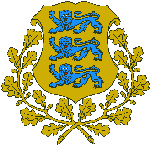
In 1990, with the initiative and support of Jenik Radon(CC'67), Columbia University founded the Eesti Fellowship, the first foreign public service internship in the then USSR. This program was modeled on existing Washington D.C. legislative assistantship programs. Since its establishment, the Eesti Fellowship has included approximately twelve students each summer who serve in positions of public interest in Tallinn, Estonia. The Eesti Fellowship now claims over 60 participants. With the experience gained from the Eesti Fellowship, several Fellows have gone on to reap significant academic, leadership, and professional rewards, including Rhodes and Marshall scholarships and USA Today All American Academic Honors.
The Eesti Fellows' list of past accomplishments is a tribute to their dedication and hard work. To mention just a few: Milton Otto worked directly with Estonian President Lennart Meri as his personal assistant, participating in organizing the historic 1994 meeting between the presidents of the Baltic States and U.S. President Bill Clinton. Agnes Nagpal was instrumental in securing needed medical supplies from the U.S. for Tallinn's Children's Hospital. Tom Bollyky wrote the principal manual for defining and creating a process of accreditation for Estonian institutions of higher learning, which served as the basis for a sizeable grant from the European Union in the amount of 400,000 ECU. His draft on university acreditation was eventually enacted into law. Jeffrey Li and Rebecca Miller successfully guided several Estonian enterprises through the privatization process. Amer Ahmad initiated the process of establishing diplomatic relations between Estonia and Saudi Arabia. In their work each of the Eesti Fellows clearly demonstrated a commitment to public service.

Each summer twelve to fifteen students spend June and July in Tallinn, Estonia where each interns in an office of the Estonian Government or in another place of public service. Participants receive compensation in Estonian currency (the Kroon). The 1996 Eesti Fellows worked for the following: the Ministries of Environment, Education, Economy, and European Integration; The Estonian Investment Agency; Office of the President; Estonian National Radio; City Paper; The Baltic Times; The Baltic Review; the Tallinn Children's Hospital; Levicon.
Housing is provided by the Tallin Pedagogical Institute, located just a few blocks away from a supermarket and shopping center, the central post office, and a tram and bus stop. Eesti Fellows share a spacious dormitory apartment and work in offices within walking distance.
Estonia is a former Soviet Republic (independence, 1991) located on the eastern edge of Eastern Europe. It shares a southern border with Latvia, an eastern border with Russia, and a northern border with the Baltic Sea. Tallinn (population 440,000), the capital of and largest city in Estonia (population 1.6 million), stands on the northern coast, only one and half hours by ferry from Helsinki.
Tallinn's Old Town is its center of business, political, and social activity. Encircled by a low stone wall and paved with cobble stones, marks of its medieval foundations, the colorful and often crowded (at least in summer) Old Town offers a contrast to the rest of Tallinn, which is paved in asphalt and pollution and is covered with thick, grey block buildings and empty Soviet factories, remainders and reminders of the communist not-so-past past.
There were plenty of (extra-curricular) things to do in Tallinn, where we would observe the few loud American "Let's Go" tourists we saw with disdain--from the perspective of the "residents" we had become. There were sedate expatriot bars with pretentious foreigners and less sedate Irish bars with live Irish music. There was a friendly dance club that charged as low as a dollar admission if you arrived before ten and were of the right gender. Several festivals and concerts were conducted in the nearby town square in the well-lit June/July evenings during which the sun set for only a few hours each night.
On weekends, when we were not required to go to work, we traveled extensively in and outside of Estonia. We visited Vilnius, Lithuania via an overnight twelve hour bus ride followed by a daytime tour of the beautiful but battered baroque buildings and basilicas. Riga, Latvia--the largest city in the Baltics with a population of 800,000--required only four hours on the slow bus. We spent the Fourth of July weekend walking through St. Petersburg and Moscow and riding to and from on overnight Russian trains. Travel from Tallinn to these nearby capital cities is inexpensive considering the cost of covering comparable distances by train or bus in the U.S.See the group journal entries for individual opinions of the summer.